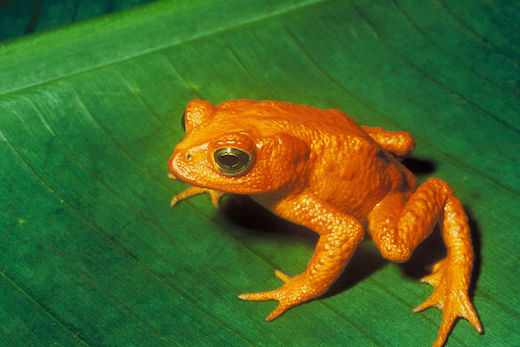Golden Toad

Extinct 1989
The golden toad was part of the Bufonidae family which consists of over 500 toads. The lifespan of the toad isn’t currently known although other toads in the species live about 10-12 years on average. The males were about 2 inches long and usually bright orange in color. The skin of the toad was bright and shiny and looked like they had been painted according to some accounts. The female of the species was longer than the male and were black or dark olive in color. They also had scarlet spots which were encircled by yellow. Above the eye socket the female hade larger cranial crests than their male counterpart. Other names for the toad include Monte Verde Toad, and Alajuela Toad. This toad is now extinct.
Habitat
The golden toad was found in the Costa Rica’s Monteverde Cloud Forest Reserve over an area of about 4 square kilometers. They had porous skin and were very sensitive to temperature and moisture. If they had an absence of moisture, it was difficult for them to breed properly and numbers went down. The toads used to breed heavily after a good rain from March and June. The females would lay about 200 eggs each and these would hatch in about two months’ time. Males would fight with other males for a chance to breed with the females. They fed on a diet of small insects.
Reason for Extinction
In 1987 it was a dry year in their habitat which lead to a reduction in breeding. An ecologist was visiting the area and saw the toads breeding in May. The ecologist returned five days later, but found the pools in the areas drying up and the eggs covered in mold. In May the ecologist returned and of over 43,500 eggs found only 29 tadpoles actually survived as the ground dried too quickly for the eggs to hatch. Their habitat had begun to warm up and this decreased mists. The decline actually started around the mid-1970s due to the atmosphere and the oceans warming. Cloud formations in Costa Rica began to form at higher elevations. This change also led to disease outbreaks which impacted the toads. Weather patterns like El Niño left warmer breeding pools which were unsuitable for the toads to breed in. There was also heavy rainfall and a higher pH balance in the water. All of these factors interrupted the breeding patterns of the toads, leading to their decline. In May 1989 the last golden make toad was sited and since then no other toads have been seen. The weather conditions created a chytrid fungus to occur which attacked the skin of the toad. The skin gets thick and since amphibians can’t absorb salts and water through the skin the lesions of the skin deter oxygen from entering their bodies which ends up in eventual suffocation. There are other theories as to why the toads went extinct, but the main one is the change in climate which interrupted the breeding process enough to kill off the eggs, decreased the numbers of toads and eventually caused them to go extinct.